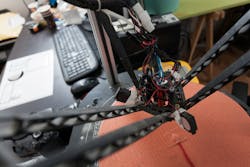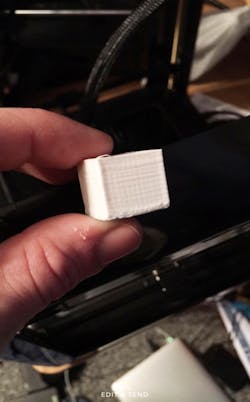3D Printing Tips and Tech: What You Need to Know about 3D Printing
The 3D printing experience for a consumer is one which will come with many different viewpoints and opinions. I was introduced to the 3D printing world around 10 months ago after purchasing my first 3D printer. My experience has been nothing short of a whirlwind. Like many other engineers I was intrigued by the idea of being able to design something and then have it created right in front of my eyes. The idea of actually owning my own 3D printer seemed outrageous and out of my budget. As I began to learn more about 3D printers, I soon realized there was a whole market of consumer printers available for a relatively low price. This is when I began to realize I might actually get the chance to own a 3D printer.
After several months of research, I finally felt like I had a good grasp of what 3D printing would entail, but I only knew a very small part of what was coming. The features I found to be important were build size, a heated bed, and whether or not the printer required proprietary filament. I wanted to have the ability to print fairly large objects, this eliminated a large part of the market. I wanted to be able to print an object at least 5” × 5” × 5”, I finally settled with a printer with the build area of 7” × 7” × 7”. This would allow me to print large objects.
For me a heated bed was an absolute must. Without a heated bed you must use a variety of tricks in order for the print to stay secured to the bed during the print. Without the heated bed the user must apply a thin layer of glue from a glue stick or cover the bed in blue painter’s tap. This will keep the print secured to the bed during the print, but it leaves the bottom of your print looking less than satisfactory. Using these extra techniques can also be a hassle.
3D printer bed-adhesion failure
Another hassle is that some printers on the market only allow the user to use their brand’s filament. In most cases the cost of using proprietary filament is significantly more than nonproprietary filament. Whenever a printer can use non-proprietary filament, the options for color and type increase significantly.
I was able to convince two of my cousins to split the cost of a 3D printer with me, allowing us to get into 3D printing with a relatively small amount of money from each of us. Once we had finally received our 3D printer ,we instantly began printing anything and everything, no matter if it was useful or not. We were amazed just watching it start with nothing on the build plate and then a few hours later having a physical part in our hands. At first we experience decent success with small objects with minimal detail.
However, we soon started to experience failure after failure, with no telltale signs of why they were happening. This is where things began to become frustrating for us. We would try adjusting some settings in hopes that it would fix our problems. The longer that we had these issues, the more frustrated we became. Every time we thought we were making progress and we would have a couple of successful prints in a row, a new issue would arise. These struggles went on for months. After more failed prints than we wanted to count, and one equipment failure, we were finally able to print parts on a fairly consistent basis. We never expected to have so much difficulty getting consistent prints.
From this experience I learned that consumer 3D printers have made huge strides in recent years. At first this technology was only available for businesses and certain people who were willing to pay the high price tag. These machines required a huge initial investment and few if any consumers were able to purchase them.
In the past few years the prices of 3D printers have reduced drastically. This has made them accessible to the consumer market, especially engineers and hobbyists. While 3D printers have grown in popularity and become more accessible, this success comes with different challenges than the high-end 3D printer has. While a good percentage of the consumer 3D printers produce great quality prints, many are inconsistent and inevitably cause frustration with the consumer. This can come from poor settings, bad filament, or even possibly cheap parts inside of the 3D printer.
Cheap parts are something to be aware of whenever researching and buying a 3D printer. If the printer has cheap parts inside, most likely the quality of your prints will suffer. Generally if a printer is priced much cheaper than what seem to be comparable printers, then that printer is most likely using parts that are cheap and that will not perform well.
I believe the hot end is the most important part of the 3D printer, and it is likely that with lower-end 3D printers this is where they save their money in order to sell it for a lower cost. Another way to avoid these 3D printers would be to find reviews where the person reviews the printer extensively. You can find a review for almost every single 3D printer, and odds are if you cannot find a review on one that it is not something you should be investing your hard-earned money into.
Many quality issues come from improper settings whenever a 3D model is sliced into code for the printer. I made the mistake of adjusting three or four different settings at one time and this made determining what went wrong if the print failed more difficult. It’s important to adjust one setting at a time in order to ensure you are adjusting the settings correctly. The most important settings to get set correctly are:
- Layer height
- Retraction
- Temperature
Layer Height
3D printers are able to print at a layer height starting as high as 0.4mm and go as low as 0.1mm or lower. As layer height is lowered, the finer details the print will have, and in theory the better it will look. But this is not always the case. When using a 3D printer, you must experiment and figure out the sweet spot for your specific printer’s layer height.
3D printer issues from poor layer height settings
Retraction
Retraction is what happens whenever the 3D printer needs to move from one spot of the print to another without extruding any material. The printer will retract the filament into the nozzle to keep it from leaving strands of material across the print. This is a key setting because too much retraction and when the printer stops traveling and begins to print again, the material may not begin to flow immediately, causing imperfections. Too little retraction and whenever the printer travels it will leave strings of filament that will make the print look undesirable.
Temperature
The last key setting is the temperature of the hot end. The hot end is where the filament is melted and then extruded out of the nozzle. If the hot end is too hot, it can also lead to stringing of the filament across the print. However, if the temperature is too low, the layers of the print will not fully bond together.
With all of these settings I believe the best place to start is what the manufacturer of the 3D printer or the filament recommends. Then perform simple test prints to tune the settings. Remember to choose one setting to adjust at a time. Once you are satisfied with it, then move on to the next setting.
In addition, making small adjustments is always better practice so as to not go overboard and cause new problems. This can be time-consuming, and rather boring, but it will save a lot of time and frustration in the long run.
3D printing is becoming more and more accessible, but all 3D printers still have their quirks that must be worked through. Even with these quirks, 3D printing has made significant strides forward in recent years and will continue to improve as the technology continues to advance. I learned about a lot of these challenges first hand and even though my experience had its ups and downs, the experience was an exciting one and it has started a new passion for me.
About the Author
Adam Beachy
Adam Beachy is an engineering technology student at Illinois State University.


